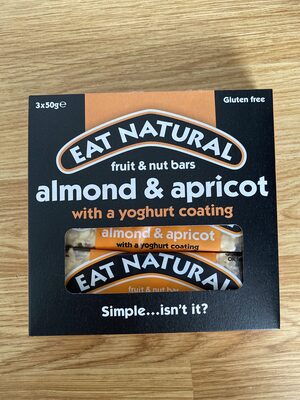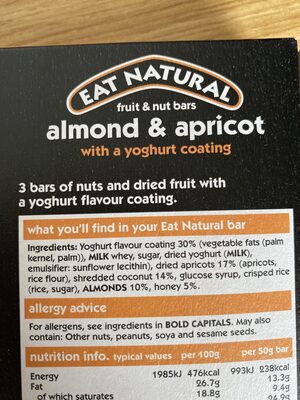Eat Natural Almond & Apricot Bars - 3 x 50g
This product page is not complete. You can help to complete it by editing it and adding more data from the photos we have, or by taking more photos using the app for Android or iPhone/iPad. Thank you!
×
Barcode: 5013803620332 (EAN / EAN-13)
Quantity: 3 x 50g
Packaging: fr:PENSEZ AU TRI ! FILM PLASTIQUE A JETER ETUI CARTON A RECYCLER
Brands: Eat Natural
Categories: en:Plant-based foods and beverages, en:Plant-based foods, en:Fruits and vegetables based foods, en:Snacks, en:Sweet snacks, en:Fruits based foods, en:Nuts and their products, en:Bars, en:Nut bars
Labels, certifications, awards: en:No gluten, en:Vegetarian, Crossed Grain Trademark, DZG glutenfrei
Origin of ingredients: An Rìoghachd Aonaichte
Manufacturing or processing places: Royaume-Uni
Stores: Carrefour Market, Carrefour
Countries where sold: A' Bheilg, An Fhraing, An Rìoghachd Aonaichte
Matching with your preferences
Environment
Packaging
Transportation
Threatened species
Report a problem
Data sources
Product added on by teolemon
Last edit of product page on by guezguez-majed.
Product page also edited by ben74, corrigo, dorado-jerome, driveoff, ecoscore-impact-estimator, gala-nafikova, jrfl, kiliweb, openfoodfacts-contributors, packbot, roboto-app, scanbot, sebleouf, segundo, swipe-studio, tacite, thoro, yuka.MLBcMt2XL_UgG_D11L1ohha1Jfr8J6dWHkwSog, yuka.RzVJSk1xZ3pnZFVwc1BBTXJ6UE0wL2xGMnBXV1UybU9LT0FQSWc9PQ, yuka.sY2b0xO6T85zoF3NwEKvlklMcOuAkGzoLhHgxnek-f6HIYXUfP5b-qrna6o.










